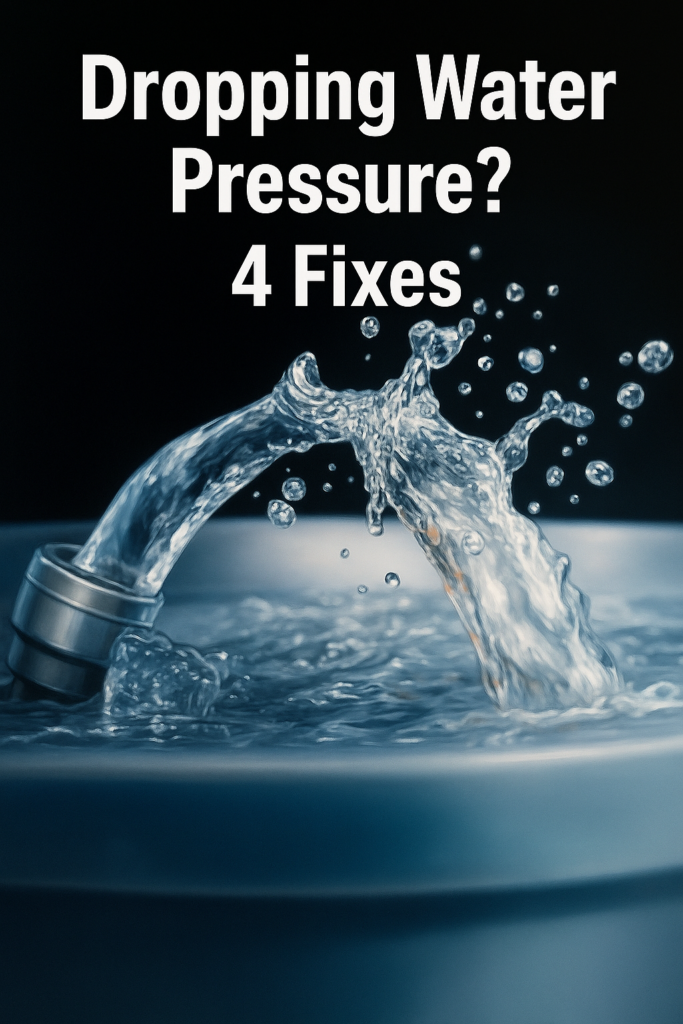Few things are more frustrating than starting a shower or doing the dishes, only for the water pressure to suddenly drop.
Consistent water pressure isn’t just a comfort—it’s essential. When the flow starts strong and then weakens, it’s usually a sign that something deeper is going on.
To restore proper pressure, you need to uncover what’s causing the problem. And often, diagnosing the issue is harder than fixing it.
In this guide, we’ll walk you through both.
Here’s why your water pressure starts high, then suddenly drops—and what you can do about it.
Fixing Water Pressure That Starts Strong, Then Drops
If your water pressure begins strong and then fades, the fix is often simple—once you identify the source of the issue. It could be something inside your home’s plumbing, or a problem with the municipal water supply.
Let’s break down the systems that control your water pressure and what might be causing the drop:
Common Causes of Water Pressure Drops
1. Stop Valves
These valves are typically found under sinks and control water flow to individual fixtures. If they’re partially closed or improperly adjusted, you’ll experience weak pressure. Double-check they’re fully open.
2. Main Shut-Off Valve
This is the primary control for water entering your home. If it’s not fully open, pressure will be low throughout the house. Locate it (often near the water meter or where the main line enters your home) and ensure it’s fully open.
3. Pressure Reducing Valve (PRV)
Installed near the main valve, this device regulates the overall pressure. If it’s malfunctioning or misadjusted, it can cause fluctuating or low pressure. Professional calibration or replacement may be required.
4. Municipal Water Supply
If everything inside your home checks out, the issue could be external. A municipal supply problem (like low pressure from the source) is out of your hands—contact your local water provider if you suspect this.
Specific Issues and How to Fix Them

Faulty Piping
Cracked, corroded, or leaky pipes can let air in, reducing pressure. Signs include hissing sounds, air bubbles in the water, or wet spots on walls. Here’s how to fix it:
- Inspect pipes for corrosion, leaks, or damage.
- Listen for spraying sounds or look for stains.
- Shut off the main valve before repairs.
- For minor damage, use a pipe clamp or epoxy putty.
- For extensive issues, contact a plumber.
Clogged Pipes
Clogs can reduce flow, especially where the pipe connects to the main line. Signs include gradual pressure loss or water that doesn’t flow at all.
- Detach the pipe and use a cleaning solution.
- Manually remove the blockage with a brush.
- If cleaning fails, replace the pipe—this may require a plumber.
- Avoid aggressive DIY methods that could cause more damage.
Defective Valves
Old, rusty, or partially closed valves restrict water flow. Be sure to:
- Fully open the main and stop valves.
- Replace worn-out or damaged valves.
- Hire a plumber if you’re unsure—they can install new ones properly.
Pressure Regulator Malfunction
A failing PRV can’t maintain consistent pressure, especially when multiple fixtures are in use.
- A professional can test and adjust or replace the regulator as needed.
- DIY work is not recommended due to the sensitivity of this component.
Can You Fix Low Water Pressure?
Yes, but it depends on the cause:
- Minor clogs and valve issues can often be resolved DIY-style.
- For major pipe damage or regulator issues, call a professional to avoid temporary fixes that won’t last.
- If no internal issues are found, ask neighbors if they’re having similar problems—this could point to a municipal issue.



